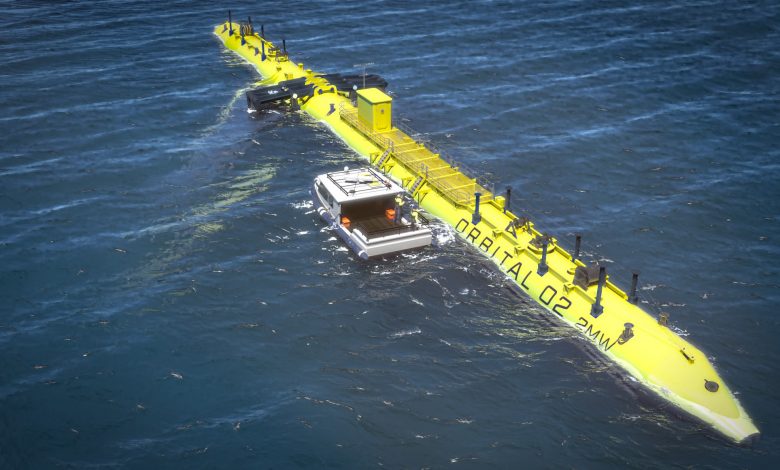In waters north of Scotland, a firm wants to set up a tidal power farm

[ad_1]
This illustration depicts how the Orbital O2 turbine will look when in the water.
Orbital Marine Power Ltd
Located in waters off the north coast of Scotland, the archipelago of Orkney is known for its natural beauty, varied wildlife and long summer days.
It is also home to the European Marine Energy Centre, or EMEC. Set up in 2003, EMEC acts as a hub where wave and tidal energy developers can test and assess their technologies in the open sea.
If all goes to plan EMEC — which has received funding from a range of institutions, including the Scottish and U.K. governments and European Union — will soon be the site of a significant milestone for one tidal energy company.
At the end of March it was announced that Orbital Marine Power had signed up for a second berth at the center, a development that will enable it to eventually launch a 4 megawatt (MW) floating tidal turbine farm.
The business, which has offices in both Edinburgh and Orkney, is currently developing its O2 tidal turbine.
With a 72 meter long “floating superstructure” that’s used to support two 1 MW turbines, the technology will, the company says, be able to generate enough electricity to meet the annual needs of 1,700 U.K. homes.
“Rather than our turbines being fixed to the seabed looking like a wind turbine, they are fixed to a floating platform which we can anchor in really fast flowing tidal streams,” Andrew Scott, the CEO of Orbital Marine Power, told CNBC via email.
Orbital’s first O2 turbine is due to be connected to the grid at EMEC by the end of this year and fully operational in 2021. It’s estimated that the second turbine will be installed in 2022.
Oceans of potential?
The U.K. is home to a number of firms developing marine based renewable energy schemes.
“The U.K. is a world leader in developing innovative tidal and wave energy projects, with over 50 companies working to generate marine power,” Luke Clark, director of strategic communications at RenewableUK, said in a statement issued to CNBC.
“We have a great natural resource with 50% of Europe’s tidal energy and 35% of its wave energy,” Clark added.
While the U.K. is something of a hub for ocean energy, projects are also springing up in other parts of the world.
At the end of 2019, for instance, it was announced that another Scottish business, Nova Innovation, had been issued with a permit to develop a project in the Bay of Fundy, Nova Scotia.
At the time, Nova Innovation said a total of 15 tidal stream turbines would be installed by the year 2023. The project, the business said, would produce enough electricity to power 600 homes.
In its own statement, Nova Scotia’s Department of Energy and Mines said the scheme would be up to 1.5 MW in size. Electricity produced by the turbines will be sold to Nova Scotia Power for 50 Canadian cents (around 36 cents) per kilowatt hour.
Looking to the future
Tidal power has been around for decades — EDF’s 240 MW La Rance Tidal Power Plant in France was built as far back as 1966 — and the tech will no doubt develop over the coming years.
This technology can be placed within the context of the global energy transition, which refers to a shift from fossil-fuel based sources of energy to renewable ones such as solar and wind.
Orbital Marine Power’s Andrew Scott sought to highlight some of “unique features” of tidal stream energy that distinguished it from other renewable sources.
Among other things, he explained that tidal energy was “totally predictable because we can predict the orbits of the moon far into the future.”
“That means we can know days, weeks, even years in advance when turbines will be generating power,” he added.
At the moment, the impact of sources such as tidal and wave energy on the planet’s overall energy mix is small. Last year, for example, 1.52 MW of tidal stream capacity was added in Europe, according to Ocean Energy Europe. For wave energy, additions were 0.6 MW.
To put these numbers into some sort of perspective, figures from WindEurope show that European countries installed just over 3.6 gigawatts of offshore wind capacity in 2019.
Ocean energy clearly has a long way to go, but the technology could, in the years ahead, have a big role to play in transforming the global energy mix.
Source link





